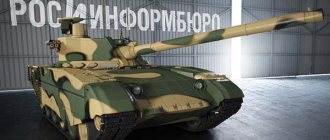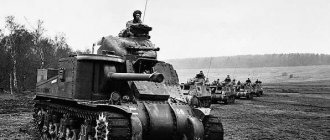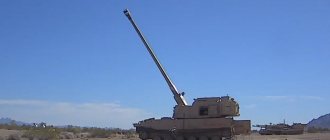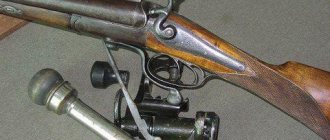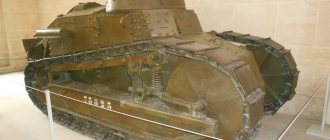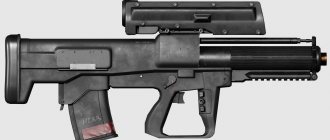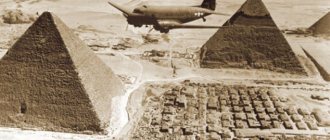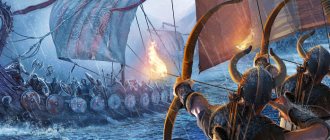| Infantry weapons chambered for intermediate and low-impulse cartridges (from top to bottom): 5.45 mm AK74M assault rifle; 5.45 mm Nikonov AN-94 assault rifle; 5.56 mm FN/CAL assault rifle (Belgium); 5.56 mm rifle G.36 (Germany). |
Weapons of infantry and motorized rifle units are the most popular type of weapons. It, like no other type of modern weaponry, is divorced from command and control systems and is least involved in the overall mechanism of combat influence on the enemy.
Motorized rifle troops are armed with barrel, rocket, mine and other types of weapons.
Carryable weapons of motorized rifle troops are usually represented by small arms and close combat weapons.
The influence of motorized rifle troops on the enemy in combat is achieved by the weapon and physical strength of the soldier in approximately equal measure. The physical strength of a soldier is used mainly for carrying weapons during maneuvers, transferring from a traveling position to a combat position, preparing positions, and controlling fire. The fire capabilities and scale of impact of small arms on the enemy are limited by a person’s muscular strength and his reserve of biological power.
In the middle of the 20th century. The armed forces of our country had enormous power. Strikes by troops and motorized rifle units could be replaced by the massive use of artillery, aviation, and tactical missiles. The role of small arms in combined arms combat was declining. The improvement of infantry weapons was greatly influenced by conditions such as the power of other branches of the military and the system as a whole, constructive continuity, personnel training, and traditions.
The presence of infantry fighting vehicles (IFVs) in rifle squads (not in all states) greatly strengthened them, but also reduced the role of other small arms. Attention to improving small arms was weakened.
For example, in 1974, the AK-74 assault rifle entered production and service, losing in terms of firing efficiency to the SA-006 assault rifle (A.S. Konstantinov) in the competition. The adoption of the AK-74 into service was carried out by the military, despite the contrary opinion of industry representatives.
The PKM machine gun, adopted in 1969, had a complex of combat properties characteristic of peacetime conditions: record low weight, high reliability, long service life, ease of maintenance. However, in terms of accuracy of combat from a bipod it was inferior to the machine guns adopted before it: DP, RP-46, RPD, RPK, in practical rate of fire - RP-46, SGM and the machine gun of the 1910/30 model, which it replaced in the troops as a rifle machine gun mouth. The situation was somewhat improved only by 2000 with the adoption of the PKP machine gun.
Due to the reduction of the Russian Armed Forces in 2000-2010. their structural, systemic power has significantly decreased. Today, a company commander, especially from brigade structures, to a greater extent than before, has to rely on the strength and effectiveness of his weapons - small arms, BMP guns, grenade launchers. It should be remembered that the battle is conducted by units that have a certain staffing and range of weapons. The right combination of weapon effectiveness and optimal organizational structure serves as a reserve for increasing the combat capabilities of units.
WEAPONS OF INFANTRY AND MOTORIZED UNITS
The weapon of infantry and motorized rifle units is a set of technical means used to destroy enemy personnel and equipment, transported to the battlefield on foot in a dismounted combat formation or on vehicles from a dismounted combat formation.
Motorized rifle units are armed with weapons of various physical principles of destruction - small arms, artillery, rocket, cold and mine, hand grenades.
The main type of infantry weapon is small arms. Artillery is represented by BMP cannons and mortars, missile weapons - rocket-propelled grenade launchers and ATGMs. Mine weapons are used as engineering means of obstacles, and not as directed weapons.
The general function of infantry weapons is to fire at targets under conditions of visual contact with the enemy and respond with fire and maneuver.
Ground Forces (SV)
In today's lesson we will talk about the type of troops
which almost every country has is
the Ground Forces
.
Flag and emblem of the Ground Forces
Ground troops
- This is a branch of
the Armed Forces
designed to
cover the state border, repel attacks of the aggressor, hold occupied territory, defeat groupings of troops and capture enemy territory.
Ground troops
can be
equipped
differently, have different
weapons and equipment
.
In accordance with this, the ground forces
include:
motorized rifle, tank and missile troops
, as well as
air defense
troops .
In addition, the ground forces
includes
special troops
- these include
units and formations of reconnaissance, communications
,
nuclear technical troops
,
technical support troops
and the like. We will look at the main troops and some of their weapons.
Let's start with motorized rifle troops
.
These troops
can
conduct combat operations
both
independently
and
jointly
with
other branches of the military
, and
are trained to operate
both in conditions of
the use of conventional weapons
and in conditions
of the use of nuclear weapons
.
The tasks of motorized rifle troops
may also include:
breaking through enemy defenses, developing an offensive, holding captured terrain and destroying the enemy
.
In small arms of the ground forces
includes:
Makarov pistol (PM), Kalashnikov assault rifle (AK74M), modernized Kalashnikov machine gun (PKM), Dragunov sniper rifle (SVD), also NSV-12.7 machine gun and automatic mounted grenade launcher (AGS-17)
.
Armament of motorized rifle troops
Gun
designed for
combat at short distances
.
Kalashnikov
assault rifle
and are designed to
destroy manpower
and destroy
enemy fire weapons
.
The NSV machine gun
can also be used
against lightly armored vehicles
and
low-flying air targets
.
A sniper rifle
, of course, is designed to hit
single targets
(including
camouflaged ones
, for example,
an enemy sniper
).
The grenade launcher
is designed to destroy
personnel
and
fire weapons
located
outside shelters
, in open trenches, as well as in hollows, ravines, on reverse slopes of heights, and the like.
Purpose of small arms
Now, let's move on to the tank forces
.
They, of course, are the main striking force of the ground forces
and are therefore mainly used on
the main axes of defense and offense
.
As a rule, tank forces
achieve the final objectives of a battle or operation in a short time due to the fact that they are able to make fullest use of the results of
fire strikes
.
The main tasks of tank forces
are:
breaking through enemy defenses, developing tactical success in operational and strategic operations, as well as defeating the enemy after using nuclear strikes
.
Tank forces
They have the following
weapons and equipment
:
T-90S tank, armored personnel carrier (BTR-90), infantry fighting vehicle (BMP-3)
, and
airborne combat vehicle (BMD-3)
.
Let us immediately note that the airborne combat vehicle
as part of
the ground forces
is, of course, intended for
joint operations
with
paratroopers
.
The T-90S tank
is designed to
break through enemy defenses
, develop
tactical success
in operational and strategic operations, and also to
defeat the enemy
after using
nuclear strikes
.
As for the armored personnel carrier
, it is intended for
transporting personnel
and for
fire support
when dismounting.
But an infantry fighting vehicle
not only
transports personnel
, but can also
destroy enemy anti-tank
and
anti-personnel weapons
, as well as
repel attacks by enemy tanks, helicopters
and
low-flying aircraft
.
Armament and equipment of tank forces
Finally, consider the missile forces
and
artillery
.
They are the main means of nuclear
and
fire destruction of the enemy,
both in
front-line
and
corps operations
, as well as in
combined arms combat
.
However, as you understand, you need to be able not only to attack
, but also
to defend
;
the air defense troops
are designed for .
Their main tasks are to cover a group of troops
,
facilities
and their
rear from enemy air strikes
.
They are capable of destroying aircraft
and
unmanned aerial vehicles
, both independently and in conjunction with the air force, and can also conduct
radar reconnaissance
.
In the missile and artillery armament of the ground forces
includes:
the Tochka-U tactical missile system, the Nona-SVK self-propelled gun, the Vena automated self-propelled gun, the Zoo-1 radar complex, and the MSTA-S self-propelled howitzer
.
The tactical missile system
is designed to
destroy
the most
important targets
that are located in
the tactical depth
the enemy troop
formation .
That is, the strength
of this
complex
lies not so much
in destructive power
, but in
high accuracy
.
Self-propelled guns
are designed to
destroy enemy personnel
,
fire weapons
,
command and observation posts
or
armored targets
.
The radar complex
, as you might guess, is designed for
fire reconnaissance
of such weapons as
mortars
,
artillery
,
multiple launch rocket systems
and
tactical missiles
.
Simply put, the radar system detects
the use of the above means and
ensures
the use of its own similar means.
Finally, a self-propelled howitzer
is designed to
destroy artillery batteries
,
tanks and armored
,
destroy
defensive
structures
,
suppress command posts
, and
destroy enemy personnel
and
fire weapons
.
Missile and artillery weapons of the Ground Forces
Today we got acquainted with the composition of the Ground Forces
and some of
their equipment
.
As the name implies, the Ground Forces
are designed to
conduct combat operations primarily on land
.
They are capable of leading an offensive
and
repelling an enemy invasion
of the country, both
independently
and
in cooperation with other troops
.
The Ground Forces
include various branches of the military, which we met in today's lesson.
FIRE MEANS
A fire weapon is a collection of weapons, people and devices working together in combat. Without any of the components of this totality, firing is impossible.
Light machine guns designed according to the principles of Soviet weapons practice: 7.62 mm RPK light machine gun; 5.45 mm RPK74 light machine gun; 5.56 mm light machine gun MG.36 (Germany) |
To solve the problems of infantry combat, fire weapons of larger units belonging to senior commanders can also be used.
Tactical fire weapons (company, battalion, regimental) are fire weapons that are subordinate to the commander of only a given unit (company, battalion, regiment) and are qualitatively different from the main weapons of this unit. Qualitative differences in weapons imply differences in fire capabilities and other performance characteristics.
Dowries are fire assets allocated by a senior commander temporarily at the disposal of a junior.
Supporting fire assets are those that work for a certain period at the request of someone other than their commander, but are not transferred to his subordination.
Reinforcement means are called attached and supporting fire weapons.
An artillery gun is a barreled weapon with a caliber of 20 mm or higher, designed to convert the potential energy of a charge into the kinetic energy of a thrown artillery shell.
Small arms are weapons that fire a bullet.
Close combat weapons are part of infantry weapons that affect the enemy by shooting, but are not related to small arms or artillery.
Typically these are grenade launchers - artillery weapons with low ballistics and low impact on the shooter.
Their purpose, composition and main types of weapons
Air Force.
Their purpose, composition and main types of weapons.
Ground troops.
SV is a type of aircraft designed to conduct combat operations primarily on land. SVs are the most numerous type of aircraft. According to their combat capabilities, ground forces are capable of independently or in cooperation with other types of armed forces to repel an enemy invasion, conduct an offensive in order to defeat groupings of enemy troops, and firmly hold occupied territories and lines.
Organizationally, the Army consists of divisions, units, formations and associations.
The composition of the Ground Forces of the Armed Forces of the Russian Federation includes the following types of troops: motorized rifle, tank, missile troops and artillery, air defense troops; special troops, units and units of the rear.
Motorized rifle troops –
the most numerous branch of the military, forming the basis of the Army. They are equipped with weapons to destroy ground and air targets, missile systems, tanks, artillery and mortars, anti-tank guided missiles, anti-aircraft missile systems and installations, reconnaissance and control equipment.
Tank forces –
the main striking force of the ground forces and a powerful means of armed warfare, designed to solve the most important tasks in various types of combat operations.
Rocket Forces and Artillery –
the main firepower and the most important operational means in solving combat missions to defeat enemy groups.
Air defense of the SV is one of the main means of defeating enemy air. They consist of anti-aircraft missile, anti-aircraft artillery and radio-technical units and subunits and are designed to cover ground forces' combat formations from enemy air forces.
Special troops,
included in the Army, ensure the successful implementation by combined arms formations of the tasks facing them. They include: intelligence, communications, electronic warfare, engineering, radiation, chemical and biological protection, nuclear technical, technical support, automotive and rear security; military units and logistics institutions.
The Armed Forces are a branch of the Armed Forces designed to solve, independently and in cooperation with other types of Armed Forces, various tasks on continental, ocean and sea theaters of operations, destroying enemy nuclear forces, defeating (weakening) its aviation groups, air support for the Army and Navy, conducting aerial reconnaissance and air transportation, troop landing, communications and control.
Structurally, the Air Force consists of aviation, the branches of which are bomber (long-range, front-line bomber), attack, fighter, reconnaissance, military transport, special purpose aviation, army aviation and air defense forces, the branches of which are anti-aircraft missiles (ZRV) and radio engineering (RTV) ) troops.
Long-range aviation (LA) is the strike force of the Air Force, a component of the strategic nuclear forces, and consists of heavy bomber aviation divisions. It is armed with Tu-22M3, Tu-160, Tu-95M.
Front-line bomber aviation includes Su-24 bomber aviation regiments, which are part of mixed aviation divisions.
Assault aviation consists of assault aviation regiments that are part of mixed aviation divisions. The main attack aircraft in the Air Force is the Su-25.
Fighter aviation consists of fighter aircraft, which are usually part of air defense corps and divisions. The fighters in service are Su-27, MiG-31, MiG-29.
Reconnaissance aviation is represented by reconnaissance aviation regiments that are part of the Air Force and Air Defense Army, which are armed mainly with Su-24mr, there is one squadron of MiG-25rb.
Military transport aviation (MTA) is organized organizationally into military transport aviation divisions, divisions into regiments, which are armed with long-range turbojet military transport aircraft of various payloads: super heavy - An-124, heavy - Il-76 and An-22, medium - An-12. Air Force and Air Defense associations have their own transport aviation (Tu-154, Tu-134, An-72, An-26, An-24, An-12, Mi-8).
Special purpose aviation is represented by control aircraft, AWACS, jamming aircraft, tankers: Il-18 (VzPU), A-50 (based on Il-76MF), An-12 (jamming container), Il-78 refueler (based on Il-76MF), 76), Su-24 – refueler.
Army aviation (SV Aviation) is intended to operate directly in the interests of combined arms formations, consisting of air support, aerial reconnaissance, tactical landings and other tasks.
Today the Russian Air Force is one of the main types of armed forces. Possessing high mobility, maneuverability and combat power, the Air Force is capable of quickly transferring efforts from one direction to another, penetrating deep behind enemy lines and influencing his targets from the air, using various weapons and electronic warfare in any weather conditions, time of day and year. .
The air defense troops were created as a branch of the USSR Armed Forces; they were intended to fight enemy air, protect administrative, political, industrial centers from air strikes and cover important military and other facilities.
The Air Defense Forces include: anti-aircraft missile troops and radio engineering troops, which were branches of the Air Defense Forces. In 1998, the Air Defense Forces became part of the Air Force. (SAM: S-200, S-300, S-75, S-125, radar systems: P-14a, K-66, ST-68).
AMMUNITION FOR INFANTRY WEAPONS
The combat properties of a weapon are determined by the energy of the shot, which in turn depends on the mass of burnt gunpowder. The mass of the loaded powder is a characteristic of the cartridge.
Let us accept the following classification of cartridges by energy.
Rifle (rifle-machine gun) weapons have a recoil impulse of at least 12 N*s and a muzzle energy of a bullet of at least 3500 J.
The design characteristics and energy of rifle cartridges have established themselves as the best for single-fire shooting at uncovered manpower within the range of naked eye visibility. At the same time, rifle cartridge bullets have a high penetrating effect on obstacles of natural origin: natural and man-made.
Pistol cartridges with a recoil impulse of no more than 4 N*s. The design characteristics and energy of pistol cartridges are limited by the purpose of the pistol - hitting targets with single fire while holding the weapon with one hand.
Intermediate - medium energy cartridges between rifle and pistol. The design characteristics and energy of intermediate cartridges have been established as the best for firing bursts from individual weapons at uncovered manpower at a distance of up to 400 m. The recoil impulse of intermediate cartridges is about 8 N*s, the muzzle energy is about 1800 J.
Low-pulse - cartridges with a recoil impulse of 5...6 N*s and a muzzle energy of at least 1200 J. The design characteristics and energy of low-pulse cartridges were established based on the maximum probability of hitting human figures when firing bursts from a wearable weapon at all combat distances. Low-pulse cartridges combine the external ballistics of rifle bullets and the impact on the shooter at the level of pistol cartridges.
Modern means (systems) of armed struggle and their damaging factors
a) Conventional means (systems) of destruction
It is known that the basis of combat operations is weapons, which are understood as devices and means used in armed struggle to defeat (destruct) the enemy.
It should be noted that modern weapons, having great destructive power and range of influence, are capable of destroying not only manpower, weapons and military equipment of the warring parties, but also causing significant damage to the civilian population and economic facilities in order to disable the military-economic potential of the warring parties. states - the material basis for waging war.
In this regard, a qualitatively new assessment of the enemy’s modern weapons (nuclear and conventional), especially those used against military and civilian targets located throughout Russia, is required, as well as the expected consequences of hitting them with means of defeating the enemy.
It should be borne in mind that the study of modern weapons of destruction and their performance characteristics will be considered only according to those parameters that will be used in nuclear and conventional war, mainly against economic facilities located in the operational and strategic depths of Russia, with the aim of undermining its main military economic potential (EPP).
Weapons are the general name for devices and means used in armed struggle to destroy enemy personnel, equipment and structures [TSB, vol. 18, p. 538-540].
The development of weapons depends on the method of production and especially on the level of development of the productive forces. The discovery of new physical laws and energy sources leads to the emergence of more effective or new types of weapons, which causes significant and sometimes radical changes in the methods and forms of warfare and in the organization of troops. In turn, weapons develop under the influence of military art, which puts forward demands for improving the characteristics of existing weapons and creating new types of them.
Armament – a complex of various types of weapons and means ensuring their use; an integral part of military equipment.
It includes weapons (ammunition and means of delivering them to the target), launch systems, detection, target designation, guidance, control devices and other technical means that are equipped with units, units and formations of various types and branches of the armed forces.
Weapons are distinguished by belonging to a certain type of armed forces, type of troops, as well as by types of carriers - aviation, ship, tank, missile, etc. Classification of modern weapons - Fig. 2 and fig. 3.
Conventional weapons (CW) . The terms “OSB” , “conventional weapons” entered the military vocabulary after the advent of nuclear weapons, which have immeasurably higher destructive properties.
However, at present, some types of conventional weapons, based on the latest achievements of science and technology, are very close in their effectiveness to WMD (volume explosion ammunition).
Conventional weapons consist of all fire and strike weapons using artillery, anti-aircraft, aviation, small arms and engineering ammunition (AP) and missiles in conventional ammunition, incendiary AP and fire mixtures.
Ammunition (AM) is an integral part of weapons designed to defeat enemy personnel, destroy his military equipment, destroy fortifications, structures and perform other tasks (lighting the area, transferring propaganda literature).
The action of the bulk of BP is based on the use of energy released by explosives, due to which the defeat (destruction, destruction) of various targets occurs.
A significant part of the ammunition can be created taking into account the type of armed forces (arms): for the Ground Forces, Air Force and Air Defense, Strategic Missile Forces and Navy, and in the future, space-based.
Conventional ammunition includes : artillery and mortar rounds; rockets; ATGM; aerial bombs (guided and unguided); small arms ammunition; hand and rifle grenades; means of explosion; explosive charges; mines (including sea mines); torpedoes; lighting and signal sockets.
| Armament is a complex of various types of weapons and means that ensure their use (an integral part of military equipment). | |||
| Includes | |||
| weapon | delivery means | ammunition | |
| Devices: detection, targeting, guidance and control | |||
| OSB | WMD | Unconventional destruction systems (NSS) - weapons of global destruction | |
| Strelkovoe | Nuclear weapon. | Biotic | Electromagnetic (EMOR) |
| Artillery | |||
| Rocket | Chemical weapon | Ethnic | Environmental (EOR) |
| Mine | |||
| Torpedo | Biologist. weapon | Geophysical (GFO) | |
| MLRS | Atmospheric (Aor) | ||
| ATGM | Hydrospheric (Horus) | ||
| Av.bombs (AB) | Lithospheric (ENT) | ||
| WTO (UAR,UAB) | Climatic (Cor) | ||
| Wing missiles (CR) | |||
| BP volumetric adult | |||
| They'll light it up. (Zor) |
Rice. 2. Classification of weapons
| Weapons - devices and means used in armed struggle to defeat and destroy enemy manpower, equipment and structures | |||
| Means of direct destruction | Means of delivery to the target | Control and guidance devices (devices) | |
| Classification characteristics | |||
| 1. By the scale of the damaging factor | |||
| Regular weapons | Weapons of mass destruction | ||
| 2. By energy sources and type of impact | |||
| Firearms | Jet | Nuclear | Chemical |
| Mine-explosive | Biological | ||
| 3. By the nature of the combat missions being solved | |||
| Tactical | Operational-tactical | Strategic | |
| 4. By type of armed forces and types of troops | |||
| Strelkovoe | Artillery | Aviation | Marine |
| Armored | Rocket | ||
| 5. If possible, change the flight path | |||
| Uncontrollable | Managed | ||
| Homing |
Rice. 3. Classification of traditional means of destruction
APs are delivered to the target by throwing from firearms (shells, mines, rifle grenades, bullets), using various engines (missile, torpedo), dropping from a height onto the target (air bombs) or throwing manually (hand grenade). Some BP are installed on the ground or in water (mines) and operate (explode) upon contact with a target or when the target passes within the range of action of the ammunition.
There are BPs (mines) that are installed on a destructible object and explode at a set time or according to a signal transmitted via radio (wires).
Ammunition in conventional ammunition (their warheads) is divided into: high-explosive, fragmentation, cumulative, armor-piercing, concrete-piercing, incendiary, cassette and special.
In addition, ammunition (warheads) can be classified according to the corresponding control (guidance) systems: unguided and guided (radio command, semi-active radar; passive IR; passive IR and inertial; laser; television; laser semi-active), as well as homing.
BP can also be characterized by types of fuses: mechanical, electronic contact, hydromechanical, magnetic, mechanical contact, mechanical pin, magnetic contact, etc.
The main damaging factors under direct exposure to OSB are: impact (piercing) action; blast wave action (contact action); action of an air shock wave; damage from shrapnel; fire impact.
Currently, qualitatively new ammunition has been created - volumetric explosion ammunition (BOV) . BOVs are equipped with mixtures with high calorific value (ethylene oxide, didoran, acetic acid peroxide, propyl nitrate), which during the explosion spray, evaporate and mix with air oxygen, forming a spherical cloud of fuel-air mixture with a radius of about 15 m and a layer thickness of 2-3 m. The resulting mixture is detonated in several places with special detonators. In the detonation zone, a temperature of 2500-3000 0C develops in a few tens of microseconds.
At the moment of explosion, a relative void is formed inside the shell from the fuel-air mixture. Something similar to an explosion of the shell of a ball with evacuated air (“vacuum bomb”) occurs. The main damaging factor of a BW is the shock wave.
In terms of its power, BOV occupies an intermediate position between nuclear (low-power) and conventional (high-explosive) ammunition. Excess pressure in the shock wave front of the explosive explosive device, even at a distance of 100 m from the center of the explosion, can reach 1 kgf/cm2 (zone of severe destruction).
b) Weapons (systems) of mass destruction
Weapons of mass destruction (WMD) are weapons of great lethality designed to cause mass casualties and destruction.
Weapons of mass destruction include nuclear , chemical and biological weapons .
Nuclear weapons are weapons whose destructive effect is due to the energy released during nuclear fission or fusion reactions. These weapons include various nuclear weapons, means of controlling them and delivering them to the target.
Nuclear weapons are weapons of mass destruction (WMD) of people and destruction (destruction) of various objects, structures and equipment, as they have a colossal combination of damaging factors - shock wave, light radiation, penetrating radiation, radioactive contamination and electromagnetic pulse .
A type of nuclear weapon is neutron weapon , which is characterized by increased radiation.
According to their capacity, nuclear weapons are divided into: ultra-small (less than 1 thousand tons); small (1-10 thousand tons); medium (10-100 thousand tons); large (100 thousand tons - 1 million tons); extra-large (more than 1 million tons).
Chemical weapons (CW) are military weapons, the destructive effect of which is based on the use of the toxic properties substances (AS) , capable of causing mass destruction of manpower in a short time and over large areas, while material assets are not destroyed.
Toxic agents (CA) are toxic chemical compounds that have certain properties that make it possible to use them in combat to kill people, animals, and contaminate the area for a long period.
Based on the nature of their impact on living organisms, chemical agents are divided into the following groups: nerve agents , affecting the nervous system (sarin, soman, tabun, V-gases); generally poisonous , affecting the blood and nervous system (hydrocyanic acid, cyanogen chloride, etc.); vesicants , affecting the skin, eyes, respiratory and digestive organs (mustard gas, lewisite, nitrogen mustard); asphyxiating , affecting the respiratory system (phosgene, etc.); irritants , causing irritation to the eyes and upper respiratory tract (adamsite, chloroacetophenone, etc.).
Depending on the boiling point and volatility, chemical agents are divided into persistent (SO) and unstable (NO) and can retain their damaging effect from several minutes to several hours and even days.
Biological weapons (BW) are weapons whose action is based on the use of pathogenic properties of microorganisms capable of causing various mass diseases of people, animals and plants.
The main components of biological weapons are biological agents and biological formulations created on their basis, as well as means of their use - biological munitions (missile warheads, cassettes and containers, pouring and spraying devices (aerosol generators), aerial bombs, ammunition for cannon and rocket artillery, etc. ).
Biological agents (BS) are pathogenic microorganisms (viruses, rickettsia, bacteria, fungi) and highly toxic products of their vital activity (toxins), capable of causing infectious diseases (typhus, cholera, smallpox, plague, glanders, etc.) and mass death of people and animals.
Modern achievements of chemical and biological sciences make possible the emergence and production of new types of biological and chemical weapons - ethnic and biotic weapons .
Ethnic weapons (EW) are a type of chemical weapons and biological weapons , the action of which is aimed at selectively defeating certain ethnic and racial groups of people through targeted chemical or biological effects on cells, tissues, organs and systems of the human body that have intraspecific hereditary characteristics.
When developing and creating ethnic weapons, the natural characteristics of the population of individual regions of the globe, which differently tolerate various diseases, were taken into account, i.e. their immunity to disease is taken into account.
Chemicals that affect human genes and their mutation can be used as ethnic weapons, which ultimately leads to the death of entire ethnic groups and peoples.
The targets of ethnic weapons can also be animals, plants, and soil microflora that are specific to a certain region of the Earth and constitute an important condition for the existence of people in a given region.
Ethnic weapons are one of the means of genocide (destruction of certain groups of the population on racial, national or religious grounds) and sterilization (deprivation of the ability to bear children).
Biotic weapons are a type of chemical weapons , the action of which is aimed at destroying natural resource potential (agricultural land and agricultural production).
The date of birth of this weapon can be considered November 30, 1961, when US President John Kennedy decided on the large-scale use of phytotoxic military formulations and other means of destruction of the natural environment during military operations in Vietnam.
As part of the specially designed Operation Ranch Hand, as a result of the use of herbicides and defoliants, vegetation was destroyed on 360 thousand hectares of cultivated land and more than 40% of crop areas were affected.
It is clear that both chemical and biological weapons are extremely dangerous from an environmental point of view. This danger is aggravated by the fact that at the present stage of development of science, substances can be created that are very diverse in their selective effects on different types of living organisms.
The Great Game: what weapons the Russian army received in 2021
Although the ship was launched in 2019, it arrived at the Pacific Fleet only a month ago - under its own power from the Baltic. And immediately - combat tests. A little later, for the first time in history, the Northern Fleet launched a salvo of hypersonic missiles.
The exact characteristics of the Zircons are a state secret. But, according to data including Western intelligence, the speed reached 9 speeds of sound - which is 3 km/s. And such missiles will be used not only by surface ships.
The submarine "Novosibirsk" is a multi-purpose boat. Armed with both torpedoes and missiles. Launchers are universal. They can work with both “Calibers” and “Zircons”.
For the first time in half a century, the shipbuilding giant Sevmash transferred 2 atomic ships to the fleet at once. The Borei class strategic cruiser - Prince Oleg - with 16 Bulava intercontinental missiles and the Yasen-Novosibirsk multi-purpose missile. Both will go to the Pacific Fleet, significantly strengthening it. Another cruiser, also for the Pacific Fleet, began the launching procedure yesterday.
This is already the second serial “Borey” of the updated project. A real engineering masterpiece and a gigantic labor of tens of thousands of people.
“The shafting takes a year and a half to complete. It takes up to two years. Unless there are a number of issues that arise during processing. The process is very long - the shaft is lined with fiberglass, this is an endurance process. And not just one layer. Tests. It's a very long process."
- says Evgeniy Pavlenko, head of the Sevmash mechanical shop.
Almost all of the plant’s workshops are secret, but we were able to see how the hull of the future nuclear-powered submarine is being formed. Oddly enough, submarines are assembled vertically. There should be several dozen such sections - of course, then everything will be brought into the horizontal plane, but most welding work takes place in a vertical position.
The pace picked up by the Russian military-industrial complex fairly surprised Western strategists. Reconnaissance flights along Russia's borders do not stop.
Increasingly, strategic aviation is involved in them, carrying out conditional launches of nuclear missiles at our facilities. The number of their flights near Russian borders has more than doubled.
The bet on abandoning the treaties on missile defense, open skies, and intermediate- and shorter-range missiles did not give the Pentagon the advantage it needed. And the standard tactic - to conduct any negotiations from a position of strength - failed.
“Over the past 3-5 years, Russia has jumped ahead in missile weapons, so much ahead that America now cannot catch up with us - neither America nor NATO. America has adopted its favorite hobby, that when it can’t do something, they always say “let’s negotiate,”
said the hero of Russia Sergei Lipovoy.
Russian President Vladimir Putin has repeatedly emphasized that the development of new types of weapons and the renewal of the army is a response to the actions of the United States and NATO.
“If the clearly aggressive line of our Western colleagues continues, we will take adequate retaliatory military-technical measures and react harshly to unfriendly steps,”
- he noted.
The appearance of strike systems near Russian borders is a “red line”, beyond which Russia’s security will be under threat even greater than during the Cuban missile crisis. And it’s not just that the flight time to Moscow will be reduced to 5 minutes.
“The United States does not yet have hypersonic weapons, but we know when they appear, we cannot hide this. They will supply Ukraine with hypersonic weapons, and then, under their cover, they will arm and push extremists from a neighboring state against Russia.”
, Putin said.
That is why the state program for arming and updating the Russian army is a priority. And to a large extent it has already been accomplished. More than 2,400 new and modernized types of equipment have been delivered to the Ground Forces, two new divisions have been deployed, as well as missile and anti-aircraft missile brigades. The country's air defense and missile defense systems are receiving S-350 and S-400 systems. Two new units have been formed in the fleet, and 4 surface ships have been commissioned. In the Strategic Missile Forces, almost 90% of the equipment is new. In general, in the army this figure exceeded 70 percent.
“It’s no secret, the president spoke about this, firstly, we are unrivaled in ultra-precise weapons, we have reached the highest level in military aviation technology, which I spoke about. Our opponents will need to work for a long time in order to achieve our results."
,” said Vladimir Artyakov, first deputy director of the Rostec state corporation.
Air-launched hypersonics are already in service. The formation of the first MiG-31 regiment with “daggers” on board has been completed. But not only a high-speed interceptor, but also a long-range Tu-22M3 bomber can use them.
The world recognizes Russia's leadership in another class of weapons, in addition to hypersonics - air defense and missile defense systems.
The range of the Pantsir complex is tens of kilometers. At long distances, missiles are used, and at short distances, cannons are used. And the complex sees all possible goals. If the target is small, such as a regular quadcopter, which is not always possible to detect by radar, then there is also an optical search. The complex is capable of combating small aircraft that contain almost no iron and has proven this more than once.
And recently, drones have also been classified as air defense systems. "Orion" in Crimea was able to shoot down a helicopter-type UAV.
In the United States, it seems, they still can’t believe that Russia, while losing its military budget by more than 10 times, was able to not only significantly update its army and navy, but also take the lead in the hypersonic race. And while American generals still understand the current situation, politicians were simply not ready to find themselves in the role of catching up for the first time in decades.
But many Russian tanks are already old and not as good as American ones
The arrival of more tanks into service with the Russian army raises a rather interesting question. How important is it to have several thousand more tanks in a prolonged ground war? Is it possible to destroy so many tanks in a multi-year conflict, and wouldn't all this create a situation that would favor Russian ground invasion forces?
Interestingly, the Global Firepower analysis states that the United States now has more armored vehicles at its disposal than Russia - 39 thousand armored vehicles versus 27 thousand. But even taking this into account, Russia's advantage of 6 thousand tanks cannot be ignored.
Meanwhile, military aviation will play an important role in any modern armed conflict, and the United States now has more than twice as many combat aircraft as Russia, as well as five times as many helicopters. Ultimately, it is likely that air power will determine whose ground forces will prevail on the ground, because Russian tanks will be vulnerable if the Americans gain advantage in the skies.
Russia's significant advantage in tank numbers was likely one of the reasons why the Rand Corporation concluded several years ago that Russian ground forces could quickly overrun the Baltics unless the United States sent significant reinforcements.
There are several other factors to consider, including the current technological state and complexity of Russian tanks. How many T-72s have been upgraded so that they can be at least somewhat comparable to the Abrams? Ultimately, although many details regarding the technical modernization of the T-72B tanks may not be available, they are unlikely to be able to compete with the latest modifications of the Abrams.
Among other things, the newest modifications of the Abrams are equipped with advanced long-range infrared sensors, new thermal sights to detect the heat signature of enemy vehicles, they use new armor materials and multi-functional ammunition. All this raises the question of whether the Abrams tank is capable of surpassing the Russian T-14 Armata tank.
Finally, how important are these bare numbers anyway? If an army is capable of fielding numerous combat-ready forces, does that army really need 12 thousand tanks? Don't the range, accuracy, invulnerability and combat characteristics of a tank outweigh these bare numbers? If one tank has sensors to detect and destroy enemy tanks and armored vehicles at a safe distance, then one such tank can take dozens of enemy vehicles out of the game.
The same can be said about the F-35's advantage in the air: These fighters are equipped with so many advanced sensors and weapons that they are able to detect and destroy many enemy aircraft before anyone notices them. Could it be that technical characteristics, including range, accuracy, air-ground coordination, and weapon effectiveness, matter more than numbers when it comes to modern warfare?
Chris Osborne is the defense columnist for the National Interest. Osborne previously served at the Pentagon as a senior specialist in the Office of the Assistant Secretary of the Army. He has also worked as a presenter and expert on military affairs on national television networks. He has appeared as a guest military expert on Fox News, MSNBC, The Military Channel and The History Channel. He received a master's degree in comparative literature from Columbia University.

